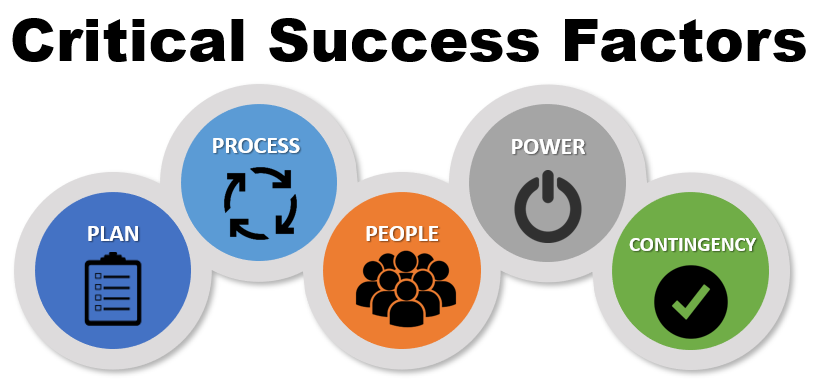Identifying the critical success factors in an organization can help bring team members together to focus on the right goals. Critical success factors are essential factors of success.
The management theory of Critical Success Factors (CSFs) was first unveiled by D. Ronald Daniel in a Harvard Business Review article and expanded on by John Rockart of MIT’s Sloan School of Management. The concept in its basic form is to define the critical success factors necessary to move an organization forward. Without doing the limited number of things exceptionally well, the business cannot achieve its goal.
CSFs are the areas that should receive intense attention and measured consistently to achieve success.
Critical Success Factors – Four Key Areas
Many organizations will develop long lists of things that have to be completed. While each of the tasks may be important, they are not as important as the CSFs. At times, they can obscure or take up team members’ time and distract them from meeting their operational goals. To avoid this, CSFs should take top priority in organizations.
Rockart pointed to four main types of CSFs:
1. Industrial Factors
These factor results from specific characteristics of your industry. For example, the things you must do to remain competitive in your business.
2. Environmental Factors
Environmental factors can range for the overall business climate or economy, to your competitors, or technological innovations that can impact your organization.
3. Strategic Factors
This is the core of the overarching competitive strategy that leaders put in place for organizations. It includes branding, positioning, and marketing.
4. Temporal Factors
These are the short-term challenges and strategies needed to overcome specific market situations or influences.
Developing Critical Success Factors
Developing an organization’s CSFs involves an in-depth analysis including key stakeholders. Even once the overall goals are established, there needs to be discussion to establish the variables that are likely to impact the desired outcome. Other key areas to analyze include:
- How do we measure whether we are meeting the goal?
- What organizational or operational changes do we need to make to meet our goals?
- Can influences outside our control impact results and how can we mitigate them?
- What tools, equipment, or skills do we need to acquire?
- Do we have the right personnel on staff to accomplish our CSFs?
- What are the key indicators to monitor?
- Can we create specific Key Performance Indicators (KPIs) to measure our success?
Organizations going through this exercise must first determine what are the true CSFs that lead to success. They should avoid creating laundry lists or defaulting to platitudes. CSFs should generally be limited to 4-5 key goals which should be defined.
The Five Critical Success Factors

CSFs should also be evaluated against the framework developed in project management circles. Here are the five critical success factors:
1. Plan
- A clear definition of the project, goals, and impact
- Access to financial resources
- Quality norms required
- Realistic establishment of timelines and midpoints
- Establishment of budgets
2. Process
- Work methodology
- Infrastructure development
3. People
- Team players
- Core competencies
- Commitment and passion
4. Power
- Experienced leaders
- Fairness across an organization
5. Contingencies
- Realistic risk and vulnerability assessments
The Relationship Between CSFs and KPIs
There should be a tight relationship between CSFs and KPIs. While CSFs will define the strategy in each of these key areas, KPIs will be how you measure performance against these strategies. CSFs are high-level goals that help shape the strategy for success. KPIs measure the degree to which success is achieved.
You can think of Critical Success Factors as input: the things you need to do to succeed. Key Performance Indicators might better be defined as outputs: they measure how well your team is doing in achieving these factors.
A CSF for a call center might be to provide superior customer service. A KPI might be a specific level of the first-call resolution. A CSF for a sales organization might be to grow market share domestically. A KPI might call for a 5% increase per quarter over the next 12 months.
Communicating CSFs and KPIs
After the development of Critical Success Factors and Key Performance Indicators, the next step is to communicate concepts and goals widely across the organization. The most effective organizations have group buOrders y-in to the core mission and a commitment to achieve the goals. Without getting this buy-in, it will be extremely difficult to achieve the CSFs.
Communicate should happen at the initial launch, at key points in an organization’s development, and during the onboarding process. It should be reflected in business and operational decisions and include refreshers regularly.
Other Classic Frameworks:
If you liked Critical Success Factor, please read about other classic frameworks by other famous authors:

